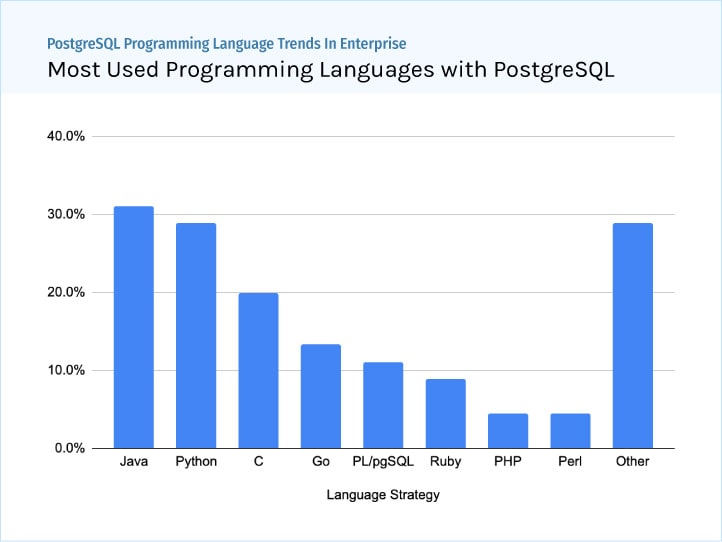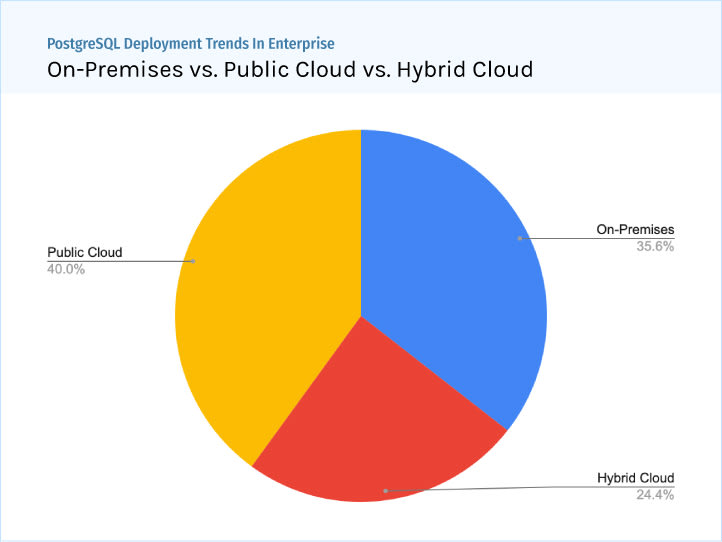PostgreSQL popularity is skyrocketing in the enterprise space. As this open source database continues to pull new users from expensive commercial database management systems like Oracle, DB2 and SQL Server, organizations are adopting new approaches and evolving their own to maintain the exceptional performance of their SQL deployments. We recently attended the PostgresConf event in San Jose to hear from the most active PostgreSQL user base on their database management strategies. In this latest PostgreSQL trends report, we analyze the most popular cloud providers for PostgreSQL, VACUUM strategies, query management strategies, and on-premises vs. public cloud use being leveraged by enterprise organizations.
Most Popular Cloud Providers for PostgreSQL Hosting
Let’s start with the most popular cloud providers for PostgreSQL hosting. It comes as no surprise that the top three cloud providers in the world made up 100% of the PostgreSQL deployments in the crowd across this enterprise report. AWS, however, has taken a significant leap from our last report, where they now average 77.4% of PostgreSQL cloud use compared to 55.0% in April. AWS does offer a managed hosting service for PostgreSQL called Amazon RDS, but there are many other DBaaS solutions that offer PostgreSQL hosting on AWS, such as ScaleGrid, that can provide multi-cloud support so you’re not locked in with a single cloud provider.
AWS was not the only cloud provider to grow - we found that 19.4% of PostgreSQL cloud deployments were hosted through Google Cloud Platform (GCP), growing 11% from April where they only averaged 17.5% of PostgreSQL hosting. This leaves our last cloud provider - Microsoft Azure, who represented 3.2% of PostgreSQL cloud deployments in this survey. This is one of the most shocking discoveries, as Azure was tied for second with GCP back in April, and is commonly a popular choice for enterprise organizations leveraging the Microsoft suite of services.
Most Used Languages with PostgreSQL
This is a new analysis we surveyed to see which languages are most popularly used with PostgreSQL. The supported programming languages for PostgreSQL include .Net, C, C++, Delphi, Java, JavaScript (Node.js), Perl, PHP, Python and Tcl, but PostgreSQL can support many server-side procedural languages through its available extensions.
We found that Java is the most popular programming language for PostgreSQL, being leveraged by 31.1% of enterprise organizations on average. PostgreSQL can be easily connected with Java programs through the popular open source PostgreSQL Java Database Connectivity (JBDC) Driver, also known as PgJDBC.
Python was the second most popular programming language used with PostgreSQL, coming in close at an average of 28.9% use with PostgreSQL. Back in 2013, PostgreSQL surveyed their users to see which external programming languages was most often used with PostgreSQL, and found that Python only represented 10.5% of the results, showing a massive increase in popularity over the past six years.
The programming language C came in third place, averaging 20.0% use with PostgreSQL, followed by Go in fourth at 13.3%, PL/pgSQL in fifth at 11.1%, Ruby in sixth at 8.9% and both PHP and Perl in seventh at 4.4%. PHP was actually the most popular language used with PostgreSQL in 2013, representing almost half of the responses from their survey at 47.1% use. The last column, Other, was represented by C++, Node.js, Javascript, Spark, Swift, Kotlin, Typescript, C#, Scala, R, .NET, Rust and Haskell.
Most Popular PostgreSQL VACUUM Strategies
PostgreSQL VACUUM is a technique to remove tuples that have been deleted or are now obsolete from their table to reclaim storage occupied by those dead tuples, also known as Bloat. VACUUM is an important process to maintain, especially for frequently-updated tables before it starts affecting your PostgreSQL performance. In our survey, we asked enterprise PostgreSQL users how they are handling VACUUM to see what the most popular approaches are.
The most popular process for PostgreSQL VACUUM is the built-in autovacuum, being leveraged by 37.5% of enterprise organizations on average. The autovacuum daemon is optional, but highly recommended in the PostgreSQL community, at it automates both VACUUM and ANALYZE commands, continuously checking tables for deal tuples. While highly recommended, 33.3% of PostgreSQL users prefer to manually perform VACUUM in the enterprise space. Fibrevillage has a great article that outlines these common problems with autovacuum which may cause an organization to adopt a manual strategy:
- autovacuum may run even when turned off to deal with transaction ID wraparound.
- autovacuum is constantly running, which makes it start over every time it runs out of space, and start a new worker for each database in your cluster.
- autovacuum can cause out of memory errors.
- autovacuum may have trouble keeping up on a busy server.
- autovacuum can easily consume too much I/O capacity.
Another surprising discovery was that 18.8% of organizations do not use VACUUM, as it is not yet needed. This may be because they are leveraging PostgreSQL in small applications or applications that are not frequently updated. 6.6% of organizations have developed a custom solution for PostgreSQL VACUUM, and 4.2% are in the process of planning their VACUUM strategy.
Most Popular PostgreSQL Slow Query Management Strategies
If you’re working with PostgreSQL, you likely know that managing queries is the #1 most time-consuming task. It’s a critical process with many aspects to consider, starting at developing a query plan to match your query structure with your data properties, to then analyzing slow-running queries, finally to optimizing those queries through performance tuning.
We found that 54.3% of PostgreSQL users are manually managing slow queries in enterprise organizations. This can be accomplished through their modules auto_explain and pg_stat_statements, checking pg_stat_activity for table and index activity on your server, analyzing the slow query log, or reviewing in your code.
On average, 21.7% of enterprise organizations are leveraging a monitoring tool to analyze and manage their PostgreSQL slow queries. This helps them significantly reduce the time it takes to identify which queries are running the slowest, most frequently, causing the most read or write load on your system, or queries missing an index by examining the rows.
17.4% of users, however, are not actively managing slow queries in the PostgreSQL deployments. We highly recommend adopting a query management strategy to ensure slow queries are not affecting the performance of your PostgreSQL deployments. 4.3% of users are currently in the process of planning their query management strategy, and 2.2% have developed a custom solution for managing their slow queries.
PostgreSQL Cloud vs. On-Premises Deployments
Let’s end with one of the hottest topics in the PostgreSQL enterprise space - whether to deploy PostgreSQL in the cloud or on-premises. We’ve been actively monitoring this trend all year, and found that 59.6% of PostgreSQL deployments were strictly on-premises back in April from our 2019 PostgreSQL Trends Report and 55.8% on-premises in our 2019 Open Source Database Report just a few months ago in June.
Now, in this most recent report, we found that PostgreSQL on-premises deployments have decreased by 40% since April of 2019. On average, only 35.6% of PostgreSQL enterprise organizations are deploying exclusively on-premise. But organizations are not migrating their on-premises deployments altogether - 24.4% of PostgreSQL deployments were found to be leveraging a hybrid cloud environment. Hybrid clouds are a mix of on-premises, private cloud, and/or public cloud computing to support their applications and data. This is a significant increase from what we saw in April, jumping from 5.6% of PostgreSQL deployments up to 24.4% in September.
Hybrid cloud deployments are becoming more popular across the board - this recent report found that 57% of businesses opt for a hybrid cloud environment using both private and public clouds as places to store their data. While we see a large jump to the cloud, enterprise organizations are still leveraging on-premises environments in some capacity 60% of the time, compared to 65.2% in April. Lastly, we found that public cloud PostgreSQL deployments have grown 15% since April, now averaging 34.8% use by enterprise organizations.
It’s also important to note that this survey was conducted at the PostgresConf Silicon Valley event, while our April survey was conducted in New York City. The bay area is widely known for adopting new technologies, which allows us to hypothesize that this market has a higher cloud adoption rate than the east coast.
| PostgreSQL Deployment Types | Apr | Jun | Sep | Apr-Sep Growth |
| On-Premises | 59.6% | 55.8% | 35.6% | -40.0% |
| Hybrid Cloud | 5.6% | 16.3% | 24.4% | 336% |
| Public Cloud | 34.8% | 27.9% | 40.0% | 15.0% |
So, how do these results stack up to your PostgreSQL deployments and strategies? We’d love to hear your thoughts, leave a comment here or send us a tweet at @scalegridio.












Top comments (0)